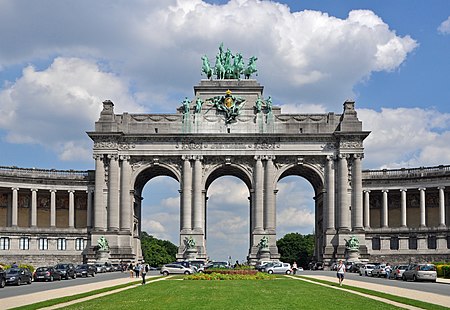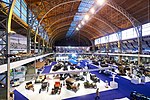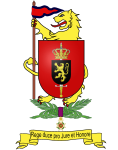Arcade du Cinquantenaire

The Cinquantenaire Arcade (French: Arcade(s) du Cinquantenaire, Dutch: Arcade(s) van het Jubelpark) is a memorial arcade in the centre of the Parc du Cinquantenaire/Jubelpark in Brussels, Belgium. The centrepiece is a monumental triple arch known as the Cinquantenaire Arch (French: Arc du Cinquantenaire, Dutch: Triomfboog van het Jubelpark). It is topped by a bronze quadriga sculptural group with a female charioteer, representing the Province of Brabant personified raising the national flag.The monument is oriented facing Brussels' city centre, on one side in the axis of the Rue de la Loi/Wetstraat which, crossing the Leopold Quarter, ends in the Royal District, seat of the Belgian Parliament, the Belgian Government and the Royal Palace; and on the other side, in the axis of the Avenue de Tervueren/Tervurenlaan, leads to the Palace of the Colonies (today's Royal Museum for Central Africa).
Excerpt from the Wikipedia article Arcade du Cinquantenaire (License: CC BY-SA 3.0, Authors, Images).Arcade du Cinquantenaire
Tunnel Cinquantenaire - Jubelparktunnel, City of Brussels
Geographical coordinates (GPS) Address External links Nearby Places Show on map
Geographical coordinates (GPS)
| Latitude | Longitude |
|---|---|
| N 50.840277777778 ° | E 4.3927777777778 ° |
Address
Arcades du Cinquantenaire - Triomfboog van het Jubelpark
Tunnel Cinquantenaire - Jubelparktunnel
City of Brussels (Brussels)
Belgium
Open on Google Maps








